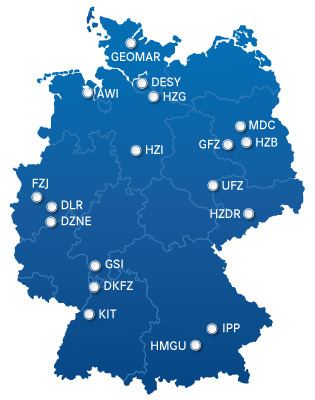Formed 2001 Website www.helmholtz.de Founded 2001 | Agency executive Otmar Wiestler Number of employees 37,148 Headquarters Bonn, Berlin | |
 | ||
Preceding agency Arbeitsgemeinschaft der Großforschungseinrichtungen (AGF) Annual budget 3.95 billion EUR (2.69 core and 1.26 third-party funding) Subsidiaries Helmholtz Centre for Environmental Research - UFZ Profiles | ||
The Helmholtz Association of German Research Centres (German: Helmholtz-Gemeinschaft Deutscher Forschungszentren) is the largest scientific organisation in Germany. It is a union of 18 scientific-technical and biological-medical research centers. The official mission of the Association is "solving the grand challenges of science, society and industry". Scientists at Helmholtz therefore focus research on complex systems which affect human life and the environment. The namesake of the association is the German physiologist and physicist Hermann von Helmholtz.
Contents
The annual budget of the Helmholtz Association amounts to more than 3.4 billion euros, of which about 70% is raised from public funds. The remaining 30% of the budget is acquired by the 18 individual Helmholtz Centres in the form of contract funding. The public funds are provided by the federal government (90%) and the rest by the States of Germany (10%).
Members
Members of the Helmholtz Association are:
Programme structure
The works of the centres are categorised into programmes, which are divided into six research groups. The Helmholtz centres are grouped according to which research group they belong to:
The Helmholtz Climate Initiative
Eight of the above-mentioned Helmholtz centers are part of the Helmholtz Climate Initiative Regional Climate (in German: Regionale Klimainitiative) REKLIM in order to tackle the interactions between atmosphere, sea ice, ocean and land surfaces. These interactions determine the climate of the Earth. Detailed observations and process studies are combined within the initiative. For the funding period 2009-2013 the REKLIM-initiative has a budget of 32.2 million Euro. In this funding period, the program is divided into seven topics, each of the topics is organized in various work-packages.
- Coupled modelling of regional earth systems. Model regions are the Arctic and Europe. Highly resolved regional model are used to simulate atmosphere, ocean, sea ice, ice sheets, land surface, soil, vegetation, aerosol chemistry and other components on a regional scale.
- Sea-level changes and coastal protection. The effects of glacier and ice-stream dynamics, the response of the ocean on heating and melt water run-off are studied in particularly for Greenland.
- Regional climate changes in the Arctic Forcing and long-term effects at the land-ocean interface
- The land surface in the climate system
- Chemistry-climate interactions on global to regional scales
- Extreme weather events Storms, heavy precipitation, floods and droughts
- Socio-economics and management Climate change adaptation and mitigation strategies
In the second funding period (2011-2015), three additional topics have been added.
